For the 2025 school year, there is 1 public preschool serving 289 students in Glendale SD 77 School District. This district's average pre testing ranking is 6/10, which is in the top 50% of public pre schools in Oregon.
Public Preschool in Glendale SD 77 School District have an average math proficiency score of 20% (versus the Oregon public pre school average of 33%), and reading proficiency score of 69% (versus the 42% statewide average).
Minority enrollment is 12% of the student body (majority Hispanic), which is less than the Oregon public preschool average of 52% (majority Hispanic).
Overview
This School District
This State (OR)
# Schools
2 Schools
91 Schools
# Students
470 Students
29,714 Students
# Teachers
32 Teachers
1,885 Teachers
Student : Teacher Ratio
15:1
15:1
District Rank
Glendale SD 77 School District, which is ranked within the bottom 50% of all 186 school districts in Oregon (based off of combined math and reading proficiency testing data) for the 2021-2022 school year.
The school district's graduation rate of 80% has increased from 40-59% over five school years.
Overall District Rank
#105 out of 189 school districts
(Bottom 50%)
(Bottom 50%)

Math Test Scores (% Proficient)
20-24%
31%
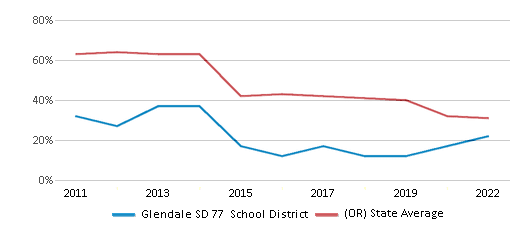
Reading/Language Arts Test Scores (% Proficient)
40-44%
44%
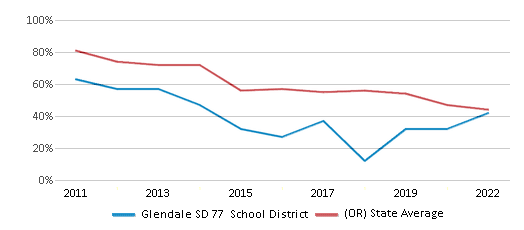
Science Test Scores (% Proficient)
11-19%
30%

Graduation Rate
≥80%
81%
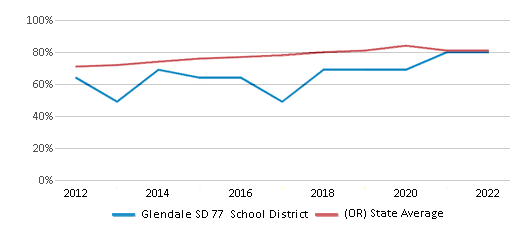
Students by Ethnicity:
Diversity Score
0.21
0.67
# American Indian Students
7 Students
200 Students
% American Indian Students
2%
1%
# Asian Students
5 Students
1,549 Students
% Asian Students
1%
5%
# Hispanic Students
33 Students
8,817 Students
% Hispanic Students
7%
30%
# Black Students
4 Students
1,664 Students
% Black Students
1%
6%
# White Students
417 Students
14,394 Students
% White Students
89%
48%
# Hawaiian Students
2 Students
371 Students
% Hawaiian Students
n/a
1%
# Two or more races Students
2 Students
2,665 Students
% of Two or more races Students
n/a
9%
Students by Grade:
# Students in PK Grade:
-
-
# Students in K Grade:
31
4,906
# Students in 1st Grade:
45
4,696
# Students in 2nd Grade:
44
4,983
# Students in 3rd Grade:
43
4,490
# Students in 4th Grade:
41
4,747
# Students in 5th Grade:
41
4,341
# Students in 6th Grade:
37
599
# Students in 7th Grade:
47
330
# Students in 8th Grade:
48
296
# Students in 9th Grade:
22
77
# Students in 10th Grade:
22
82
# Students in 11th Grade:
32
91
# Students in 12th Grade:
17
76
# Ungraded Students:
-
-
District Revenue and Spending
The revenue/student of $11,709 in this school district is less than the state median of $18,279. The school district revenue/student has declined by 40% over four school years.
The school district's spending/student of $11,464 is less than the state median of $19,325. The school district spending/student has declined by 40% over four school years.
Total Revenue
$6 MM
$9,902 MM

Spending
$5 MM
$10,468 MM
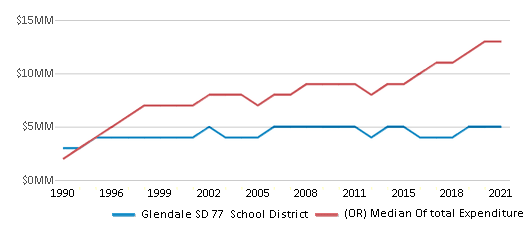
Revenue / Student
$11,709
$18,279
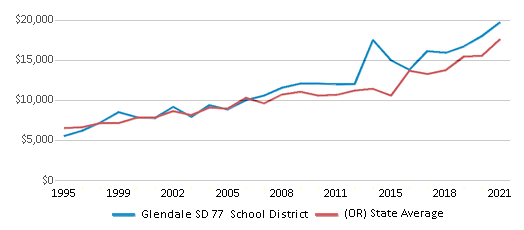
Spending / Student
$11,464
$19,325

Best Glendale SD 77 School District Public Preschools (2025)
School
(Math and Reading Proficiency)
(Math and Reading Proficiency)
Location
Grades
Students
Rank: #11.
Glendale Community Charter School Pre-k-12
Charter School
(Math: ≤20% | Reading: 60-79%)
Rank:
Rank:
7/
Top 50%10
10598 Azalea Glen Rd
Glendale, OR 97442
(541) 832-1701
Glendale, OR 97442
(541) 832-1701
Grades: PK-12
| 289 students
Recent Articles

Year-Round Or Traditional Schedule?
Which is more appropriate for your child? A year-round attendance schedule or traditional schedule? We look at the pros and cons.

Why You Should Encourage Your Child to Join a Sports Team
Participating in team sports has a great many benefits for children, there is no doubt. In this article you will learn what those benefits are.

White Students are Now the Minority in U.S. 九游体育s
Increasing birth rates among immigrant families from Asia and Central and South America, combined with lower birth rates among white families, means that for the first time in history, public school students in the United States are majority-minority. This shift in demographics poses difficulties for schools as they work to accommodate children of varying language abilities and socio-economic backgrounds.





